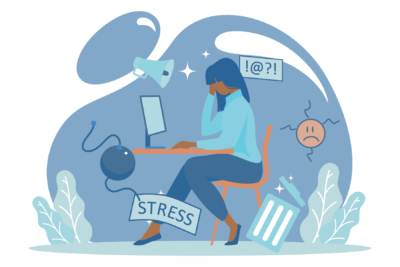 In our fast-paced and ever-evolving work environments, mental health has emerged as a critical factor influencing employee well-being and organizational success. As we navigate the complexities of modern work-life, it’s imperative to understand the multifaceted nature of mental health and its profound impact on our professional and personal lives.
In our fast-paced and ever-evolving work environments, mental health has emerged as a critical factor influencing employee well-being and organizational success. As we navigate the complexities of modern work-life, it’s imperative to understand the multifaceted nature of mental health and its profound impact on our professional and personal lives.
The Essence of Mental Health
Mental health encompasses our emotional, psychological, and social well-being. It’s the lens through which we perceive the world, make decisions, and handle stress. Far from being merely the absence of mental disorders, mental health represents a state of equilibrium where individuals can realize their potential, cope with the normal stresses of life, work productively, and contribute to their community.
The Importance of Mental Health in the Workplace
In the modern workplace, the significance of mental health at work cannot be overstated. It is a critical component of employee well-being and organizational success. Statistics on mental health at work reveal that mental health issues are a leading cause of absenteeism, with the World Health Organization estimating that depression and anxiety alone result in 12 billion working days lost each year, costing the global economy $1 trillion annually in lost productivity.
A supportive mental health environment in the workplace can lead to:
- Increased Productivity: Employees with good mental health are more likely to be focused, motivated, and productive.
- Reduced Absenteeism: Addressing mental health issues can lead to a decrease in the number of days employees take off due to mental health concerns.
- Improved Employee Morale: A workplace that supports mental health fosters a positive atmosphere, boosting overall morale.
- Enhanced Job Satisfaction: Employees are more likely to feel satisfied with their jobs when they feel their mental health is supported.
Addressing Mental Health in the Workplace
The National Fund for Workforce Solutions developed a comprehensive guide for workforce practitioners on addressing mental health, stress, and trauma in the workplace. The guide emphasizes a trauma-informed approach to workforce development, recognizing that trauma and stress can significantly impact an employee’s performance and well-being. The Substance Abuse and Mental Health Services Administration (SAMHSA) describes a “trauma-informed” organization, program, or system using the following four Rs rubric:
- Realize the widespread impact of trauma and understand potential paths for recovery.
- Recognize the signs and symptoms of trauma in clients, families, staff, and others involved with the system.
- Respond by fully integrating knowledge about trauma into policies, procedures, and practices.
- Actively resist re-traumatization.
By understanding the effects of trauma, employers can create a more supportive and resilient work environment. Here are some strategies and tips for supporting employee mental health:
- Promote Mental Health Awareness: Encourage an open dialogue about mental health to reduce stigma. Ideas for promoting mental health awareness at work can include workshops, seminars, and mental health days. Celebrating Mental Health Awareness Month and sharing personal stories can also foster a supportive culture.
- Provide Mental Health Resources: Offer access to mental health resources such as counseling services, Employee Assistance Programs (EAPs), and online support tools. Providing information on how to access these resources is key to ensuring employees feel supported.
- Encourage Work-Life Balance: Promote policies that support work-life balance, such as flexible work hours and the option of taking a mental health day off work. Encouraging employees to take breaks and disconnect after work hours can also help.
- Foster a Supportive Work Environment: Create a culture of support where employees feel valued and heard. Regular check-ins and team-building activities can enhance team cohesion. Providing a safe space for employees to express their concerns is crucial.
- Train Managers and Supervisors: Equip managers with the skills to recognize signs of mental distress and provide appropriate support. Training should include how to have sensitive conversations and how to guide employees to the right resources.
- Address Mental Health Issues Due to Work: Identify and mitigate workplace stressors that contribute to mental health issues due to work. This can include workload management, conflict resolution, and ensuring a safe working environment.
- Support Remote Workers: With the rise of remote work, it’s important to address mental health when working from home. Holding regular virtual check-ins and providing resources for remote work challenges can help maintain a sense of connection and support.
- Monitor and Evaluate: Regularly assess the effectiveness of mental health initiatives and make necessary adjustments. Gathering feedback from employees and tracking key metrics can help in understanding the impact of these initiatives.
By implementing these strategies, employers can create a workplace that not only supports mental health but also enhances overall productivity and employee satisfaction.
Supporting mental health at work is not just a moral obligation but a strategic investment in the workforce. By implementing these strategies, employers can create a healthier, more productive, and more resilient workforce. It’s time to prioritize mental health awareness and take action to support the well-being of employees in the workplace.
The National Fund for Workforce Solutions envisions an equitable future where all workers have the resources required to thrive, race does not dictate employment outcomes, and all jobs are good jobs. Together, the National Fund and our national network of 30+ communities are changing the conversation around workforce development to promote equity and drive greater impact.
Read more about the ways employers can invest in their workplaces to improve job quality for their workers. Subscribe to the National Fund email list to stay up to date with the latest in workforce development across the country.





